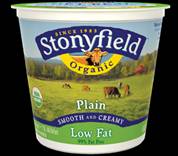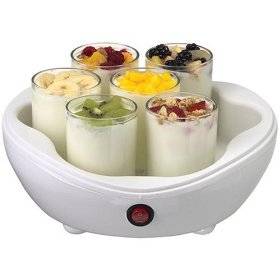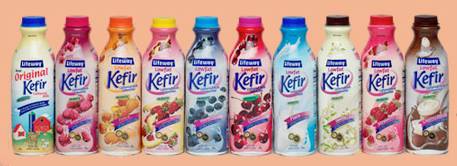• Kimchi
• Sauerkraut
Yogurt is milk with bacteria added. These bacteria feed on milk sugar (lactose), which produces lactic acid, giving yogurt its tangy taste. Yogurt is currently the most common carrier for food probiotics in the Western world
To be officially labeled "yogurt", it must contain Lactobacillus bulgaricus (moderately acid resistant) and Streptococcus thermophilus (not acid resistant). Neither of these survives the initial digestion phases particularly well or reaches the GI tract in great numbers. Look for brands labeled "probiotic" that contain more than these two basic yogurt strains, especially strains that will survive stomach and bile acid pH.
Most yogurt is made from pasteurized cow's milk in N. America - elsewhere, yogurt is made from the milk of cows, goats, sheep, yaks, water buffalo and other animals. Raw milk naturally contains probiotics, but since these are killed by pasteurization, cultures are added back into the milk to initiate fermentation.
Choose ORGANIC yogurt. Needs to be free of pesticides, chemical fertilizers, antibiotics or synthetic growth hormones.
You need at least 10 billion live colony forming
units (CFUs) to make a health difference -numbers of CFU's in yogurt can be inconsistent or even unknown.

• ORGANIC Stonyfield's yogurt line. Includes four extra live cultures: L. acidophilus, L. casei, L. rhamnosus and B. bifidus. and contains 100 million cultures per gram. (i.e. nearly 17 billion CFU/ 6 oz container), including at least 1 billion L. rhamnosus study-supported amount of HN001 strain to improve immune system function. Certified to strict organic standards. Contains no artificial flavors, colors or sweeteners;
• ORGANIC Stonyfield Activia. Contains Bifidus Regularis® (Bifidobacterium lactis DN-173 010, claimed to survive GI journey. Number of CFUs not disclosed. Dannon Activia (which is owned by Stonyfield) is NOT organic.
• ORGANIC Oikis Greek yogurt. Greek yogurt gets its extra creaminess, twice the protein, less lactose and fewer carbs of regular yogurt from a straining method that removes the whey (liquid) from the yogurt. Contains three additional live cultures (as well as S. thermophilus, L. bulgaricus): L. Acidophilus, B. bifidus, and L. casei. One serving of Stonyfield yogurt** contains at least one billion CFUs of Lactobacillus rhamnosus.
Glutathione - King of the Antioxidants
Note, however, that whey is the food containing the highest level of precursors to the body's important antioxidant glutathione, and removing the whey takes away this benefit.
• Mountain High Yogurt (NOT organic). Includes three extra strains: L, Acidophilus, B. Bifidus, L. Casei and an 8oz serving provides ~20 billion CFU.
Consuming overly-sweetened yogurt defeats the health purpose of eating yogurt. Sugar feeds the bad bacteria;
Some producers pasteurize the yogurt after the cultures are added to prolong its shelf life. This will kill off the live active cultures and eliminate health benefits. Heat > 110°F kills the bacteria.
Yogurt is low in lactose -
allows many lactose-intolerant people to get its probiotic and nutritional
benefits without digestion problems.
This is the best way to determine bacterial strains and ensure viability. Let yogurt culture for 24 hours, at low heat, in order to allow the bacteria to fully grow. Most store-bought yogurts are rapidly cultured for a couple hours at high heat. If you can obtain raw milk from cows eating organic grass so much the better!
Get creative with plain, unsweetened yogurt by adding something delicious. Chopped fruit, berries, nuts, honey, vanilla, cinnamon. Exercise your imagination!
Kefir is milk inoculated with kefir "grains". A bacterial mixture, including Lactobacillus kefiri and species of the genera Leuconostoc, Lactococcus and others, along with lactose-fermenting and non-lactose-fermenting varieties of yeast. The grains are then strained out.
• Lifeway Kefir. Claims 1 cup contains 10 billion probiotics, but an 8oz serving also contains 8-20g (2-5 teaspoons) of sugar. (divide grams by 4 to get teaspoons)
